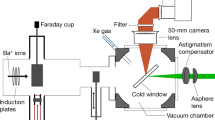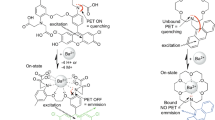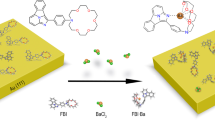Abstract
Observation of the neutrinoless double β decay is the only practical way to establish that neutrinos are their own antiparticles1. Because of the small masses of neutrinos, the lifetime of neutrinoless double β decay is expected to be at least ten orders of magnitude greater than the typical lifetimes of natural radioactive chains, which can mimic the experimental signature of neutrinoless double β decay2. The most robust identification of neutrinoless double β decay requires the definition of a signature signal—such as the observation of the daughter atom in the decay—that cannot be generated by radioactive backgrounds, as well as excellent energy resolution. In particular, the neutrinoless double β decay of 136Xe could be established by detecting the daughter atom, 136Ba2+, in its doubly ionized state3,4,5,6,7,8. Here we demonstrate an important step towards a ‘barium-tagging’ experiment, which identifies double β decay through the detection of a single Ba2+ ion. We propose a fluorescent bicolour indicator as the core of a sensor that can detect single Ba2+ ions in a high-pressure xenon gas detector. In a sensor made of a monolayer of such indicators, the Ba2+ dication would be captured by one of the molecules and generate a Ba2+-coordinated species with distinct photophysical properties. The presence of such a single Ba2+-coordinated indicator would be revealed by its response to repeated interrogation with a laser system, enabling the development of a sensor able to detect single Ba2+ ions in high-pressure xenon gas detectors for barium-tagging experiments.
This is a preview of subscription content, access via your institution
Access options
Access Nature and 54 other Nature Portfolio journals
Get Nature+, our best-value online-access subscription
$29.99 / 30 days
cancel any time
Subscribe to this journal
Receive 51 print issues and online access
$199.00 per year
only $3.90 per issue
Buy this article
- Purchase on Springer Link
- Instant access to full article PDF
Prices may be subject to local taxes which are calculated during checkout




Similar content being viewed by others
Data availability
The data that support the findings of this study are available within the paper and Supplementary Information. Additional data generated during the present study are available from the corresponding authors upon reasonable request.
References
Majorana, E. Theory of the symmetry of electrons and positrons. Nuovo Cim. 14, 171–184 (1937).
Gómez Cadenas, J. J., Martín-Albo, J., Mezzetto, M., Monrabal, F. & Sorel, M. The search for neutrinoless double beta decay. Riv. Nuovo Cim. 35, 29–98 (2012).
Moe, M. K. New approach to the detection of neutrinoless double beta decay. Phys. Rev. C 44, 931–934 (1991).
Danilov, M. et al. Detection of very small neutrino masses in double beta decay using laser tagging. Phys. Lett. B 480, 12–18 (2000).
nEXO Collaboration. Imaging individual barium atoms in solid xenon for barium tagging in nEXO. Nature 569, 203–207 (2019).
Nygren, D. R. Detecting the barium daughter in136Xe 0-νββ decay using single-molecule fluorescence imaging techniques. J. Phys. Conf. Ser. 650, 012002 (2015).
Jones, B. J. P., McDonald, A. D. & Nygren, D. R. Single molecule fluorescence imaging as a technique for barium tagging in neutrinoless double beta decay. J. Inst. 11, P12011 (2016).
McDonald, A. D. et al. Demonstration of single barium ion sensitivity for neutrinoless double beta decay using single molecule fluorescence imaging. Phys. Rev. Lett. 120, 132504 (2018).
Sakharov, A. D. Violation of CP invariance, C asymmetry, and baryon asymmetry of the universe. Pis’ma Z. Eksp. Teor. Fiz. 5, 32–35 (1967).
Fukugita, M. & Yanagida, T. Baryogenesis without grand unification. Phys. Lett. B 174, 45–47 (1986).
Gell-Mann, M., Ramond, P. & Slansky, R. Complex spinors and unified theories. In Proc. of Supergravity Stony Brook Workshop (eds Van Nieuwenhuizen, P. & Freedman D. Z.) 27–29 (1979).
Yanagida, T. Horizontal symmetry and masses of neutrinos. Prog. Theor. Phys. 64, 1103–1105 (1980).
Mohapatra, R. N. & Senjanovic, G. Neutrino mass and spontaneous parity nonconservation. Phys. Rev. Lett. 44, 912–915 (1980).
Gando, A. et al. Search for Majorana neutrinos near the inverted mass hierarchy region with KamLAND-Zen. Phys. Rev. Lett. 117, 082503–082506 (2016).
GERDA Collaboration. Improved limit on neutrinoless double-β decay of 76Ge from GERDA Phase II. Phys. Rev. Lett. 120, 132503–132505 (2018).
Alduino, C. et al. First results from CUORE: a search for lepton number violation via 0νββ decay of 130Te. Phys. Rev. Lett. 120, 132501–132508 (2018).
Gomez-Cadenas, J. J. Status and prospects of the NEXT experiment for neutrinoless double beta decay searches. Preprint at https://arxiv.org/abs/1906.01743 (2019).
Elliott, S. R. & Vogel, P. Double beta decay. Annu. Rev. Nucl. Part. Sci. 52, 115–151 (2002).
Sinclair, D. et al. Prospects for barium tagging in gaseous xenon. J. Phys. Conf. Ser. 309, 012005 (2011).
Mong, B. et al. Spectroscopy of Ba and Ba+ deposits in solid xenon for barium tagging in nEXO. Phys. Rev. A 91, 022505–022513 (2015).
EXO-200 Collaboration. Measurements of the ion fraction and mobility of α- and β-decay products in liquid xenon using the EXO-200 detector. Phys. Rev. C 92, 045504–045510 (2015).
Bolotnikov, A. & Ramsey, B. The spectroscopic properties of high-pressure xenon. Nucl. Instrum. Methods Phys. Res. A 396, 360–370 (1997).
Nygren, D. High-pressure xenon gas electroluminescent TPC for 0-ν ββ-decay search. Nucl. Instrum. Methods Phys. Res. A 603, 337–348 (2009).
Álvarez, V. et al. NEXT-100 Technical Design Report (TDR). Executive summary. J. Inst. 7, T06001 (2012).
Martín-Albo, J. et al. Sensitivity of NEXT-100 to neutrinoless double beta decay. J. High Energy Phys. 2016, 159 (2016).
Thapa, P. et al. Barium chemosensors with dry-phase fluorescence for neutrinoless double beta decay. Sci. Rep. 9, 15097 (2019).
Ji, H.-F., Dabestani, R., Brown, G. M. & Hettich, R. Spacer length effect on the photoinduced electron transfer fluorescent probe for alkali metal ions. Photochem. Photobiol. 69, 513–516 (1999).
Nakahara, Y., Kida, T., Nakatsuji, Y. & Akashi, M. Fluorometric sensing of alkali metal and alkaline earth metal cations by novel photosensitive monoazacryptand derivatives in aqueous micellar solutions. Org. Biomol. Chem. 3, 1787–1794 (2005).
Bissell, R. A. et al. Luminescence and charge transfer. Part 2. Aminomethyl anthracene derivatives as fluorescent pet (photoinduced electron transfer) sensors for protons. J. Chem. Soc. Perkin Trans. 2 9, 1559–1564 (1992).
Bourson, J., Pouget, J. & Valeur, B. Ion-responsive fluorescent compounds 4 effect of cation binding on the photophysical properties of a coumarin linked to monoaza- and diaza-crown ethers. J. Phys. Chem. 97, 4552–4557 (1993).
Li, J., Yim, D., Jang, W.-D. & Yoon, J. Recent progress in the design and applications of fluorescence probes containing crown ethers. Chem. Soc. Rev. 46, 2437–2458 (2017).
Valeur, B. & Berberan-Santos, M. N. in Molecular Fluorescence – Principles and Applications 420–436 (Wiley–VCH, 2012).
Huston, M. E., Haider, K. W. & Czarnik, A. W. Chelation enhanced fluorescence in 9,10- bis[[(2-(dimethylamino)ethyl)methylamino]methyl]anthracene. J. Am. Chem. Soc. 110, 4460–4462 (1988).
Carter, K. P., Young, A. M. & Palmer, A. E. Fluorescent sensors for measuring metal ions in living systems. Chem. Rev. 114, 4564–4601 (2014).
Golchini, K. et al. Synthesis and characterization of a new fluorescent probe for measuring potassium. Am. J. Physiol. 258, F438–F443 (1990).
Yang, J.-S., Hwang, C.-Y., Hsieh, C.-C. & Chiou, S.-Y. Spectroscopic correlations between supermolecules and molecules. Anatomy of the ion-modulated electronic properties of the nitrogen donor in monoazacrown-derived intrinsic fluoroionophores. J. Org. Chem. 69, 719–726 (2004).
Smith, G. A., Hesketh, J. C. & Metcalfe, T. R. Design and properties of a fluorescent indicator of intracellular free sodium concentration. Biochem. J. 250, 227–232 (1988).
Crossley, R., Goolamali, Z. & Sammes, P. G. Synthesis and properties of a potential extracellular fluorescent probe for potassium. J. Chem. Soc. Perkin Trans. 2 7, 1615–1623 (1994).
Aginagalde, M. et al. Tandem [8 + 2] cycloaddition-[2 + 6 + 2] dehydrogenation reactions involving imidazo[1,2-a]pyridines and imidazo[1,2-a]pyrimidines. J. Org. Chem. 75, 2776–2784 (2010).
Zhang, Y., Tang, S., Thapaliya, E. R., Sansalone, L. & Raymo, F. M. Fluorescence activation with switchable oxazines. Chem. Commun. 54, 8799–8809 (2018).
Ko, C.-C. & Yam, V. W.-W. Coordination compounds with photochromic ligands: ready tunability and visible light-sensitized photochromism. Acc. Chem. Res. 51, 149–159 (2018).
Maitra, R., Chen, J.-H., Hu, C.-H. & Lee, H. M. Synthesis and optical properties of push-push- pull chromophores based on imidazo[5,1,2-cd]indolizines and naphtho[1′,2′:4,5]imidazo[1,2-a]pyridines. Eur. J. Org. Chem. 5975–5985 (2017).
Dougherty, D. A. The cation–π interaction. Acc. Chem. Res. 46, 885–893 (2013).
Ávila, F. J., Gambín, A., Artal, P. & Bueno, J. M. In vivo two-photon microscopy of the human eye. Sci. Rep. 9, 10121 (2019).
Bueno, J. et al. Multiphoton microscopy of ex vivo corneas after collagen cross-linking. Invest. Ophthalmol. Vis. Sci. 52, 5325–5331 (2011).
Bainglass, E., Jones, B. J. P., Foss, F. W., Huda, M. N. & Nygren, D. R. Mobility and clustering of barium ions and dications in high pressure xenon gas. Phys. Rev. A 97, 062509 (2018).
Benesi, H. A. & Hildebrand, J. H. A spectrophotometric investigation of the interaction of iodine with aromatic hydrocarbons. J. Am. Chem. Soc. 71, 2703–2707 (1949).
Zhang, Q. & Duan, K. Fluorescence chemosensor containing 4-methyl-7-coumarinyloxy, acetylhydrazono and n-phenylaza-15-crown-5 moieties for K+ and Ba2+ ions. Heterocycl. Commun. 24, 141–145 (2018).
Batsanov, S. S. Van der Waals radii of elements. Inorg. Mater. 37, 871–885 (2001).
Xu, C. & Webb, W. W. Measurement of two-photon excitation cross sections of molecular fluorophores with data from 690 to 1050 nm. J. Opt. Soc. Am. B 13, 481–491 (1996).
Zinter, J. P. & Levene, M. J. Maximizing fluorescence collection efficiency in multiphoton microscopy. Opt. Express 19, 15348–15362 (2011).
Denk, W., Strickler, J. H. & Webb, W. W. Two-photon laser scanning fluorescence microscopy. Science 248, 73–76 (1990).
Byrnes, N. K. et al. Barium tagging with selective, dry-functional, single molecule sensitive on-off fluorophores for the NEXT experiment. In Meeting of the Division of Particles and Fields of the American Physical Society https://www.slac.stanford.edu/econf/C1907293/ (2019).
Amor, R. et al. Widefield two-photon excitation without scanning: Live cell microscopy with high time resolution and low photo-bleaching. PLoS One 11, e0147115 (2016).
Acknowledgements
We acknowledge the support of our colleagues in the NEXT collaboration in the development of this work as a part of the R&D programme to develop a background-free experiment based on Ba2+ tagging. We also acknowledge support from the following agencies and institutions: the European Research Council (ERC) under Advanced Grant 339787-NEXT; the Ministry of Science and Innovation of Spain and FEDER under grants FIS2014-53371-C04, FIS2016-76163-R, MAT2016-78293-C6-5-R, MINECO/FEDER CT2016-80955-P, CTQ2016-80375-P and CTQ2014-51912-REDC; Interred PCTEFA V-A Spain/France/Andorra Program (EFA 194/16/TNSI); the Basque Government (GV/EJ) under grants IT-1346-19 and IT-1180-19; and Agencia de Ciencia y Tecnología de la Región de Murcia (19897/GERM/15). The authors also thank the SGI/IZO-SGIker UPV/EHU, Fundación Séneca and DIPC for computational and analytical resources.
Author information
Authors and Affiliations
Contributions
J.J.G.-C., F.P.C. and D.N. conceived the project. J.J.G.-C. and F.P.C. coordinated the experiments and analysed the data. I.R. and B.A. carried out the chemical synthesis, characterization and solution fluorescence studies of the compounds. J.I.M. carried out the NMR experiments. C.T., F.P.C. and D.C. performed the computational studies. P.H. and C.R. designed and performed the chelation in dry medium. Z.F. carried out the fluorescence studies in the silica experiments. B.O. and T.S. performed the solid-phase experiments involving polymers. J.M.B., R.M.M.-O., P.H., F.M. and P.A. performed the laser experiments (coordinated by J.M.B.). J.J.G.-C. and F.P.C. wrote the manuscript. D.N., F.M., C.R. and Z.F. assisted in writing and editing the manuscript.
Corresponding authors
Ethics declarations
Competing interests
The authors declare no competing interests.
Additional information
Peer review information Nature thanks Mark Chen and the other, anonymous, reviewer(s) for their contribution to the peer review of this work.
Publisher’s note Springer Nature remains neutral with regard to jurisdictional claims in published maps and institutional affiliations.
Extended data figures and tables
Extended Data Fig. 1 Characterization of FBI in solution.
a, Emission spectra of unchelated (7ca; cyan) and chelated (7caBa2+; blue) indicators upon excitation at 250 nm. Red dots indicate the wavelengths used to determine the peak discrimination factor fλ. b, Photographs of the two species in acetonitrile showing bicolour emission upon irradiation at 365 nm. c, Benesi–Hildebrand plot of the fluorescence emission spectra of FBI in acetonitrile solution at room temperature in the presence of different concentrations of barium perchlorate. e, Job’s plot of the 7ca + Ba(ClO4)2 interaction, showing a 1:1 stoichiometry between 7ca and Ba2+, thus forming the complex 7caBa2+. ΔF, variation in the measured emission; X(Ba2+), molar fraction of Ba2+.
Extended Data Fig. 2 Theoretical predictions and NMR experiments.
a, b, DFT-derived gas-phase structures of 7ca (a) and 7caBa2+ (b). Bond distances are given in Å. Dihedral angles ω formed by covalently bonded atoms 1–4 are given in degrees and in absolute values. c, Frontier molecular orbital energy diagram of 7ca (left) and 7caBa2+ (right). Vertical arrows indicate the main contributions to the electronic transition to the lowest bright state. d, e, Aromatic (d) and aza-crown ether (e) regions of the proton NMR spectra of compound 7ca upon addition of barium perchlorate. The most important changes in chemical shift (in ppm) are highlighted. All the spectra were recorded at 500 MHz. Protons a correspond to the methylene groups of the aza-crown ether moiety (e). Protons b and c (d) correspond to the para-benzylidene group. See the drawing of 7ca in d for the assignment of all protons.
Extended Data Fig. 3 Computed structures of FBI–barium perchlorate complex.
DFT-derived fully optimized structure of 7ca complexed with barium perchlorate. A dummy atom located at the centre of the 1,4-disubstituted phenyl group is denoted as X. Bond distances and dihedral angles are given in Extended Data Table 2.
Extended Data Fig. 4 Titration and polymer experiments.
a, Titration experiments, showing that the response of the FBI improves for larger concentrations of barium. Eq, equivalent. b, Example of a polymer experiment, showing that the response of the FBI loses its characteristic colour shift.
Extended Data Fig. 5 Subtraction of the silica response.
a, b, Emission spectra of the SF (a) and SBF (b) samples, with the background from the silica superimposed, for an excitation light of 250 nm.
Extended Data Fig. 6 TPA microscopy.
a, Illustration of our setup. An infrared (800 nm) laser passes through a dichroic mirror and fills the back plane of the objective (20×, NA = 0.5) of an inverted microscope. The laser is focused in the sample, with a spot limited by diffraction (for example, a volume of about 1 μm3). The emitted fluorescence passes through a selection filter before being recorded by a PMT. b, Emission spectra of FBI and FBI Ba2+ for an excitation light of 250 nm (green, blue) and 400 nm (olive, cyan). The spectra are very similar, allowing the use of an infrared laser of 800 nm for our proof-of-concept study. c, Log–log plot showing the quadratic dependence of the intensity on the power, which is characteristic of TPA, for the FRS. d, Two-dimensional scan (profile) across the FRS. Integration of the profile yields an integrated signal that can be used for the normalization of the FBI samples.
Extended Data Fig. 7 Interaction of FBI with other elements (1:1 equiv.).
a–e, Blue lines represent FIB + Na+ (a), FIB + K+ (b), FIB + Mg2+ (c), FIB + Ca2+ (d) and FIB + Sr2+ (e), and the cyan lines show the corresponding unchelated indicators. In a–d, the spectra show that the FIB is not chelated with the ion, whereas in e the response is similar to that observed for barium, showing the formation of a supramolecular complex. All excitation spectra were taken at 250 nm.
Extended Data Fig. 8 Schematic of the BOLD detector.
An example of a ββ0ν signal event is shown. The two electrons emitted in the decay (purple) propagate in the dense xenon gas ionizing it, and the ionization electrons drift towards the anode, where their energy is measured by the ETD, which also reconstructs the event barycentre. The Ba2+ ion drifts very slowly towards the cathode, where it is eventually captured and identified by the BTD.
Supplementary information
Supplementary Information
This file contains: 1. General Information; 2. Analytical methods; 3. Synthetic Procedures and Analytical Data; 4. UV/Vis and Fluorescence Spectroscopy experiment; 5. UV/Vis and Fluorescence measurements of 7ca-polymer films; 6. NMR Spectra; 7. Computational details; and 8. References.
Rights and permissions
About this article
Cite this article
Rivilla, I., Aparicio, B., Bueno, J.M. et al. Fluorescent bicolour sensor for low-background neutrinoless double β decay experiments. Nature 583, 48–54 (2020). https://doi.org/10.1038/s41586-020-2431-5
Received:
Accepted:
Published:
Issue Date:
DOI: https://doi.org/10.1038/s41586-020-2431-5
This article is cited by
-
The search for neutrinoless double-beta decay
La Rivista del Nuovo Cimento (2024)
-
Demonstration of neutrinoless double beta decay searches in gaseous xenon with NEXT
Journal of High Energy Physics (2023)
-
Ba+2 ion trapping using organic submonolayer for ultra-low background neutrinoless double beta detector
Nature Communications (2022)
-
Boosting background suppression in the NEXT experiment through Richardson-Lucy deconvolution
Journal of High Energy Physics (2021)
-
Sensitivity of a tonne-scale NEXT detector for neutrinoless double-beta decay searches
Journal of High Energy Physics (2021)
Comments
By submitting a comment you agree to abide by our Terms and Community Guidelines. If you find something abusive or that does not comply with our terms or guidelines please flag it as inappropriate.



